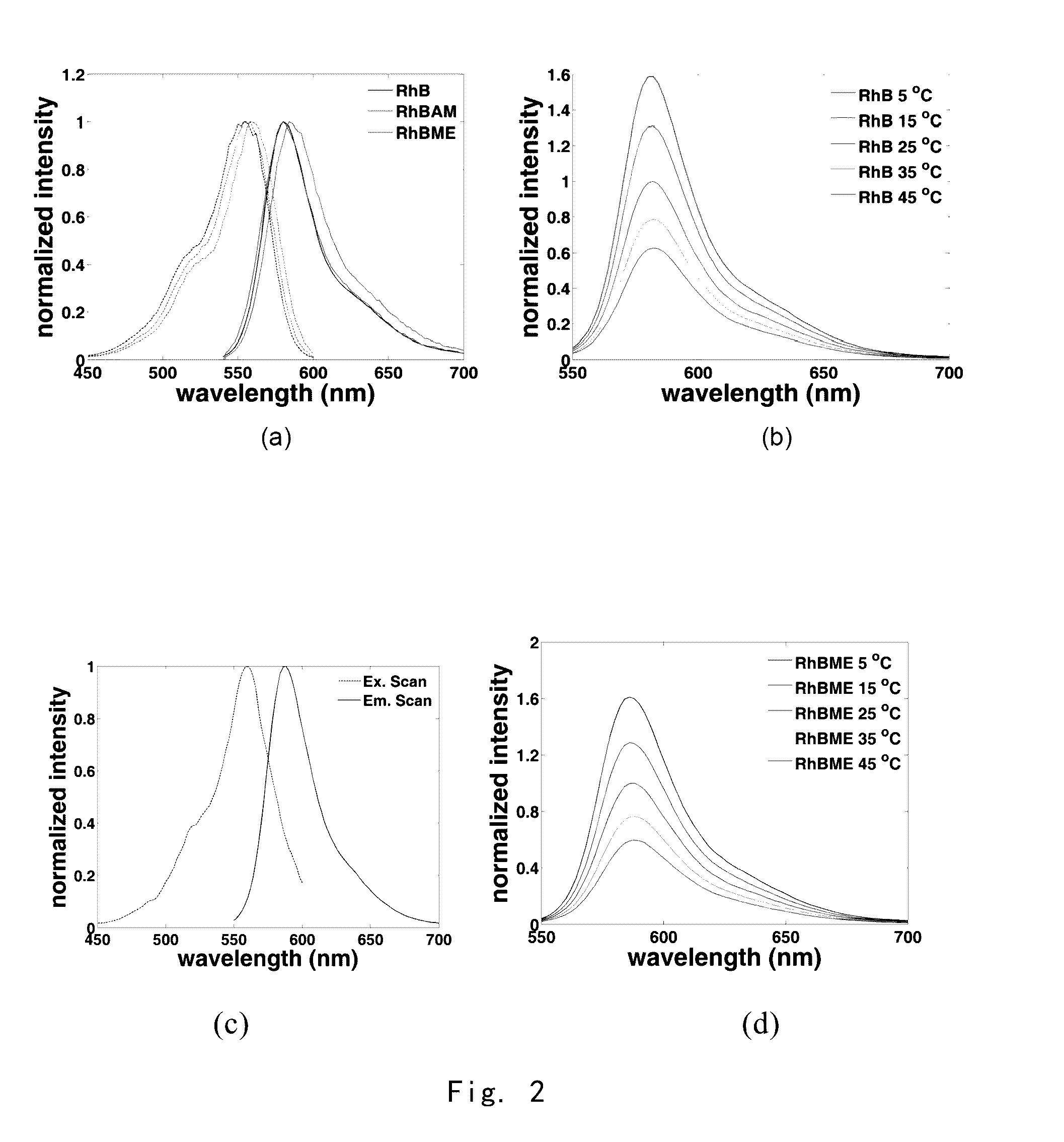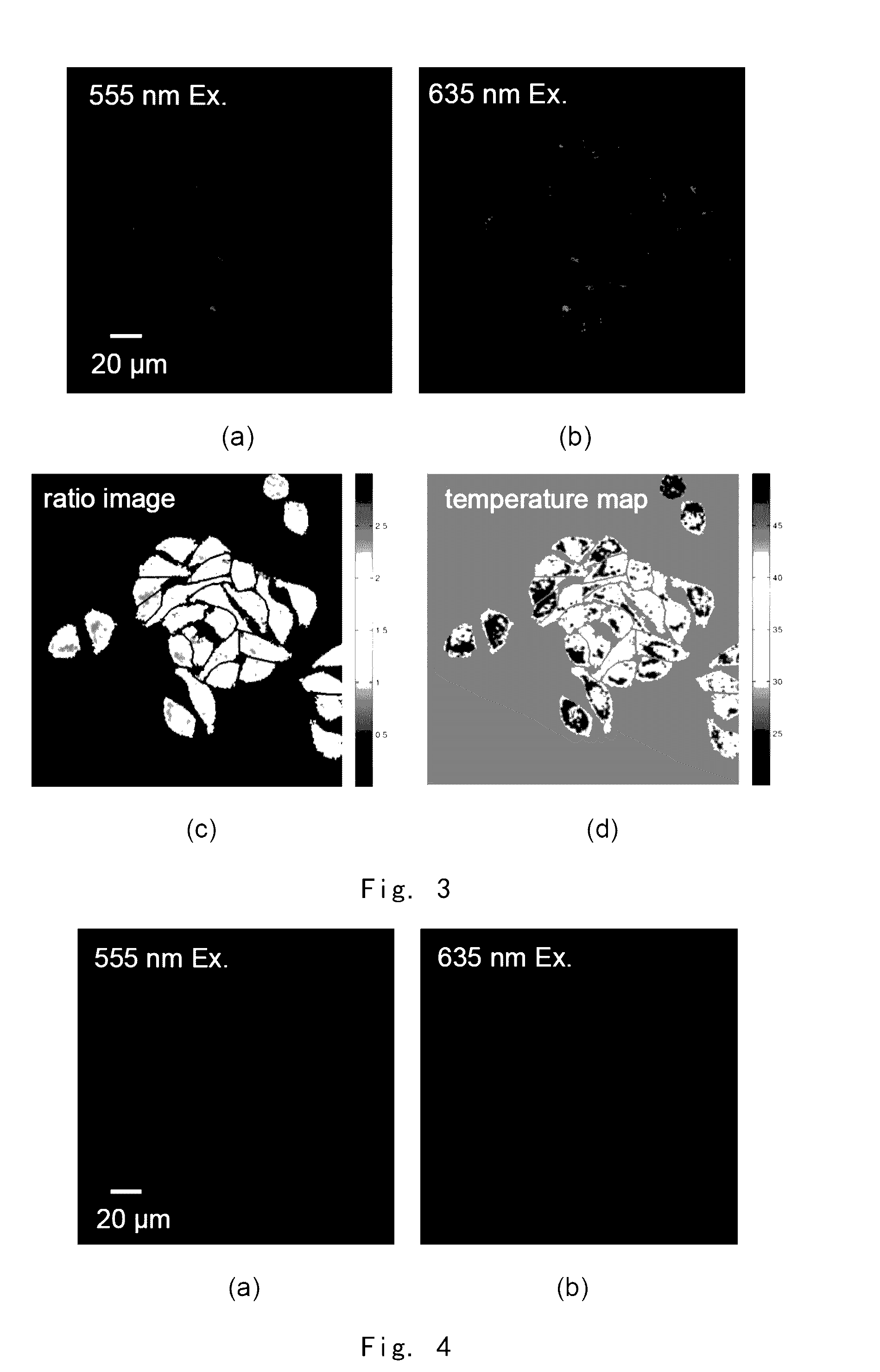Novel temperature-sensitive fluorescent compound and application thereof
a fluorescent compound and temperature-sensitive technology, applied in the field of cell detection, can solve the problems of inability to distinguish individual cells from cameras working in infrared wavelengths, difficult to measure intracellular temperature changes by using conventional methods of temperature measurement, and inability to detect intracellular temperature by infrared thermography methods, etc., to achieve accurate measurement of intracellular temperature, easy application, and high spatial and temporal resolution
- Summary
- Abstract
- Description
- Claims
- Application Information
AI Technical Summary
Benefits of technology
Problems solved by technology
Method used
Image
Examples
example 1
Synthesis of Rh101AM and RhBAM
[0223]Rh101 (purchased from Santa Cruz), cesium fluoride, and bromoacetic acid were mixed at a ratio of 1:2:1.2 and dissolved in ten times of dimethylformamide (DMF). The reaction mixture was stirred for 2 hours at room temperature, and then purified with preparative high performance liquid chromatography to obtain Rh101AM (the compound of Formula II).
[0224]Synthesis method for RhBAM is similar to that of Rh101AM:
[0225]RhB (purchased from Santa Cruz), cesium fluoride, and bromoacetic acid were mixed at a ratio of 1:2:1.2 and dissolved in ten times of dimethylformamide (DMF). The reaction mixture was stirred for 2 hours at room temperature, and then purified with preparative high performance liquid chromatography to obtain RhBAM (the compound of Formula III).
example 2
Synthesis of Rh101ME and RhBME
[0226]Rh101 and thionyl chloride were mixed at a ratio of 1:5 and dissolved in 10 times of chloroform, heated to 60° C. and stirred for 10 minutes. And then the mixture was cooled to room temperature and quenched with methanol. Afterwards, the solvent was removed on a rotary evaporator under reduced pressure, and the residue was purified through preparative high performance liquid chromatography thereby obtaining Rh101ME (the compound of Formula IV).
[0227]Synthesis method for RhBME is similar to that of Rh101ME:
[0228]RhB and thionyl chloride were mixed at a ratio of 1:5 and dissolved in 10 times of chloroform, heated to 60° C. and stirred for 10 minutes. And then the mixture was cooled to room temperature and quenched with methanol. Afterwards, the solvent was removed on a rotary evaporator under reduced pressure, and the residue was purified through preparative high performance liquid chromatography thereby obtaining RhBME (the compound of Formula V).
example 3
Measurement of the Temperature Distribution of Cytoplasm Using Rh101AM
[0229]Rh101AM was used to stain live cells and imaged under a fluorescent microscope. The fluorescenc image was calculated using equation (1), thereby obtaining the image of intracellular temperature distribution.
[0230]FIG. 3 shows Stokes luminescence image of HepG2 cells captured by EMCCD (Evolve 512, Photometrice Ltd.) under fluorescence microscope (BX61WI, Olympus Ltd., 40×lens, numerical aperture 0.8, the temperature of culture solution is 27.9□ at imaging), after the cells were stained by using 200 nM Rh101AM for 60 mins in an incubator at 37□. Wherein, 3(a) shows Stokes luminescence image from a monochromator (Optoscan monochromator, Cairn Research Ltd.), excited at a wavelength of 555 nm (bandwidth of 3 nm) and collected at 573˜613 nm; 3(b) shows anti-Stokes luminescence image from a monochromator, excited at a wavelength of 635 nm (bandwidth of 15 nm) and collected at 573˜613 nm; and 3(c) shows a ratio ima...
PUM
| Property | Measurement | Unit |
|---|---|---|
| operating wavelength | aaaaa | aaaaa |
| pH | aaaaa | aaaaa |
| wavelength | aaaaa | aaaaa |
Abstract
Description
Claims
Application Information
 Login to View More
Login to View More - R&D
- Intellectual Property
- Life Sciences
- Materials
- Tech Scout
- Unparalleled Data Quality
- Higher Quality Content
- 60% Fewer Hallucinations
Browse by: Latest US Patents, China's latest patents, Technical Efficacy Thesaurus, Application Domain, Technology Topic, Popular Technical Reports.
© 2025 PatSnap. All rights reserved.Legal|Privacy policy|Modern Slavery Act Transparency Statement|Sitemap|About US| Contact US: help@patsnap.com



